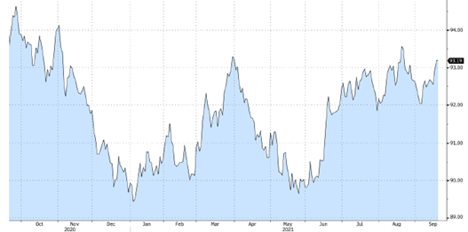
Europe’s Iron Lady: What a Thatcher-esque resolve could mean for the EU, the euro and interest rates
14 September 2021
The hour of Climate Risk has come. What does this mean for investors?
27 September 2021INSIGHTS • 21 September 2021
FX Market Eagerly Awaits Fed Guidance

Ali Jaffari, Head of North American Capital Markets
With summer officially coming to an end this week, the start to the fall season is met with a flurry of economic activity – Canadian and German elections are slated to take place this week and six major central banks will announce rate decisions / policy guidance (including the Fed, Bank of England and Norges Bank). As seen in recent weeks and months, volatility levels in major FX pairs have remained at a lull, with market participants seeking further direction. The much-awaited two-day FOMC meeting, where the Fed is anticipated to signal a timeline for phasing out its pandemic-era stimulus, is a focal point for the week and could pave the way for FX and rates markets.
Calculated Fed keeps market guessing
Compared to the last decade, the Fed appears much more calculated in its approach to discussing taper strategies and acknowledgement of market trends and economic data points, in an attempt to prevent unprecedented market moves as seen in the 2013 taper tantrum. The Fed’s pandemic support measures, which effectively doubled the size of the Fed’s balance sheet to around $8 trillion and kept rates subdued in light of spikes in inflation, is no easy feat for the Fed to pull back on, with little proven historical ‘success’ measures to go on. Therefore, broader unintended market moves and spill over effects should be considered.
There is much market chatter as to whether the Fed will actually signal a taper strategy and if so, what the impact could be to markets. In what was thought to be a turning point, the June Fed meeting floated the idea of a scale back in asset purchases and a faster rate hiking cycle with 13 out of 18 Fed members opted for a rate hike by the end of 2023. A period of USD strength ensued, reinvigorated by the July Fed meeting minutes which highlighted a growing number of Fed members residing in the camp for a taper start by year end.
The Jackson hole meeting in August was met by Fed inaction, with several members reversing course and citing heightened risk from the Delta variant. US data releases in recent weeks on retail sales, inflation and unemployment have come in softer than expected – whether it will weigh on Fed guidance at the upcoming meeting will remain a point a focus, as its evident that a labor market recovery is front and center to the Fed’s rollback on stimulus.
What to expect and the market reaction
Chart 1: Trade Weighted USD Index

Source: Bloomberg
Looking back to our 2021 outlook, our third macro scenario “Market Melt Up” projected a bout of USD strength driven by a rise in yields but was to be followed by USD weakness based on inflation spiralling out of control. As yields have been largely rangebound in recent months (10Y US treasury trading in a 1.20% - 1.40% range since July), continued inaction from the Fed, which is probable given the increased risk from the Delta variant and recent data misses, will keep rates low and place downward pressure on the USD.
If the Fed does decide to announce a scale back of asset purchases at this meeting, in order to avoid a market, upset, it would need to provide clear direction on timing and a road map as to how it plans to reduce its $120B asset purchases. I suspect this will be done gradually, i.e. ~$15B - $20B monthly pull back, to accommodate a smooth market transition. How the market actually digests this remains to be seen.
A taper signal is likely to have an imminent impact on yields, which have been trading sideways in recent weeks in anticipation of market guidance. Given the somewhat controlled approach from the Fed, we wouldn’t expect to see the same heightened escalation in Treasury yields, as seen by taper tip off in 2013, but a normalization (reversal of the recent curve flattening) of the yield curve along with an increase in nominal rates, which is likely to drive an influx of foreign capital flows and support the USD.
A rapid increase in nominal rates, however, could trigger spill over effects such as a sell off in equity markets, and an exodus of capital flows from emerging market (EM) currencies. The Fed previously noted that it would step in if risk assets get hit too hard, hence it could potentially dial back if its tapering approach doesn’t go according to plan. Also, higher rates will leave EM currencies vulnerable; it would be prudent to monitor and take note of any rapid devaluations against the USD.
Stay tuned to this week’s FOMC decision and the events that unfold. There is sufficient event risk that could impact the markets directionally. Signal or no signal, a market reaction will ensue as it takes its cue from the Fed’s messaging and current view of the economic environment. In addition, Fed projections on growth, unemployment and inflation will provide direction on the next lift-off in interest rates.
Be the first to know
Subscribe to our newsletter to receive exclusive Validus Insights and industry updates.



